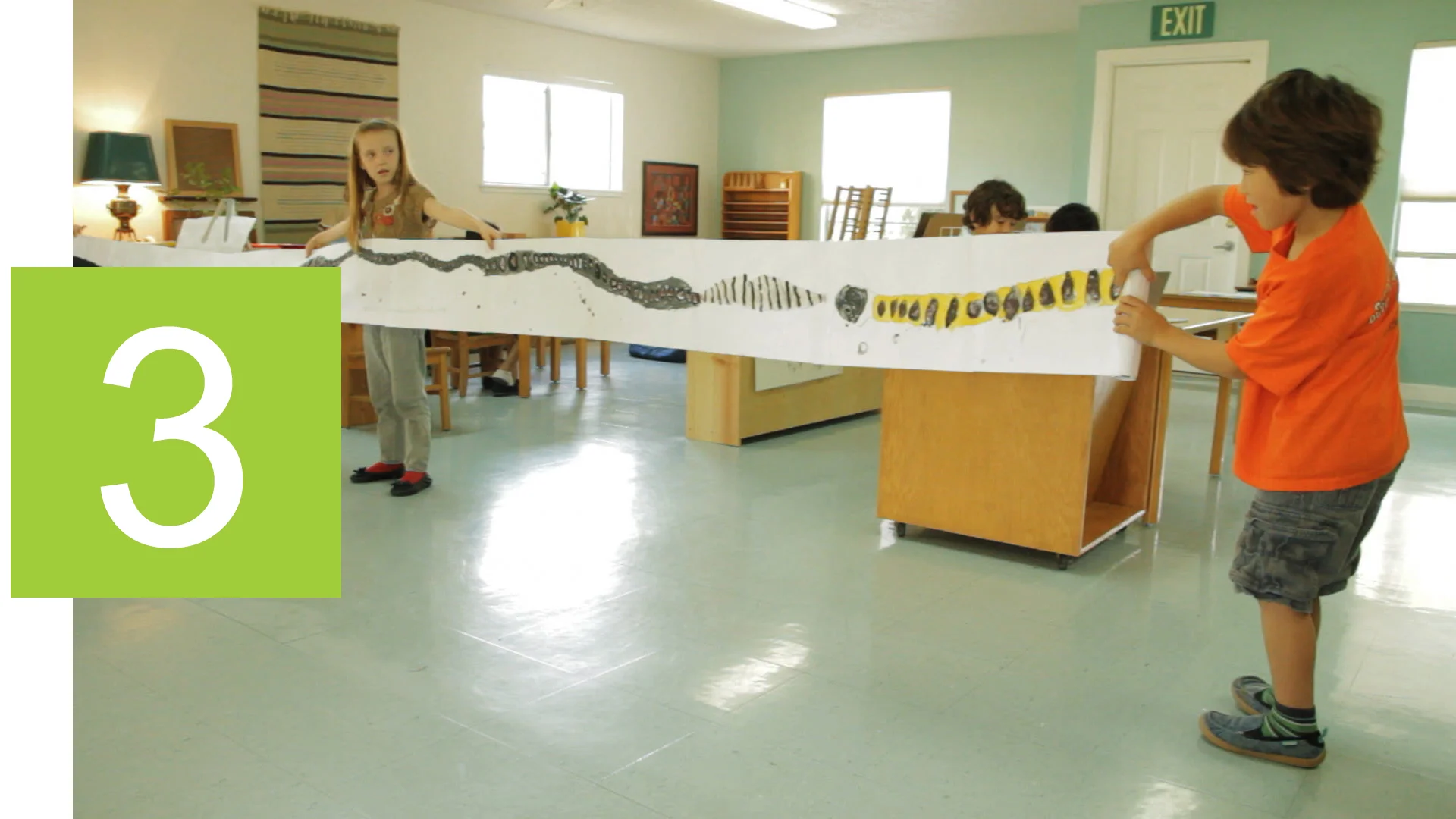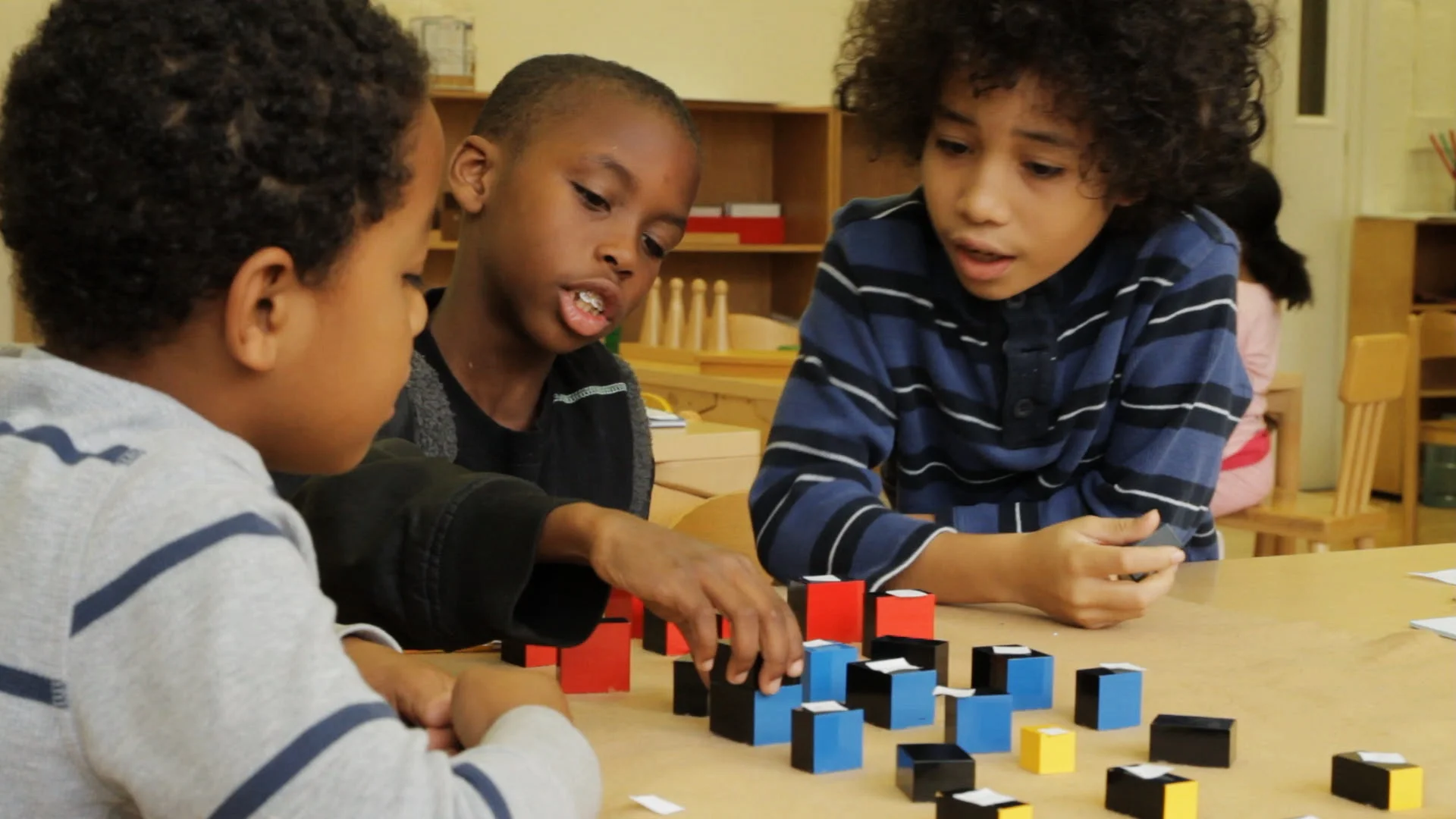Capturing Ordinary Days:
Elementary Age Work
The Montessori elementary child enters a prepared learning environment designed to address the psychological characteristics and developmental needs of his age group. Earlier experience in the primary classroom has laid the foundation of a basic skill set that allows him to function in this new setting. Engagement is spontaneous and the child is naturally drawn to group work and exploration. The elementary Montessori teacher has a set of tools she utilizes to maintain the balance of the classroom. Montessori materials designed to facilitate the transition to abstraction allow the child to not only meet society’s expectations but support an atmosphere of intellectual rigor, experimentation, and challenge. The deep ecology of cosmic education creates a social dynamic that supports the growth of community.
COLLABORATIVE LEARNING (15:34)
The elementary age child is naturally drawn to working in a group and challenging herself.
Shorts: Elementary Age Work
1. Discovery (8:23)
2. Fungus (6:02)
3. Snakes (8:34)
Delving Deeper Into Our Craft:
Elementary Age Work
The Three Essential Tools
by Melinda Nielsen
Cosmic education is the plan Dr. Montessori envisioned for the second plane child. However, the implementation of cosmic education requires an adult that is willing to assist the children in their journey to construct themselves. We have the most fabulous job in the world: telling stories about the universe and everything contained within. We are charged with igniting the fire within the child to explore the universe which leads her to discover how everything is connected. In this process the child gains an appreciation for the human beings that came before, their contributions to society and in turn ponders what her cosmic task to society may be... READ MORE
Cubing the Alphabet
During filming, a classroom was visited at the very early stages of an ambitious group work: To Cube the Alphabet. Scenes of this work are visible in the “Collaborative Learning” video. The children involved were asked to describe their project. This is their summary:
When we started this project our goal was to cube the alphabet. We wanted to start big! To cube we had to first square the alphabet. In the process of squaring the alphabet our graph paper kept on getting messed up so we decided to make the final collection of terms into a permanent project. After searching our school storeroom for materials we decided to use some leftover fabric strips and felt squares. We initially thought of felting the squares from wool but decided our time would be better spent not doing that. After experimenting with various writing tools, a fabric marker was chosen to write the collected terms on the fabric. On the felt squares a calligraphy pen and ink was used. The ink did not work on the fabric strips because the ink tended to soak and spread. After sewing the felt squares and fabric strips together our project was off to a good start.
Next our focus went to cubing the alphabet. We had the concept of constructing a three dimensional project much like the game of 3D tic-tac-toe. It would be a huge project to construct all the collected terms and a little unrealistic in the time we had, so we decided to focus on the cubes of each alphabet letter formed on the diagonal. The collected terms would be written on handmade graph paper. The first layer, all the terms from the square taken times “a” forms the base. This collection of terms, written on graph paper is glued to a clear piece of Plexiglas. The cube of “a” is glued down in its place on top of the graph paper. Next comes all the collected terms taken times “b.” It is constructed in the same manner and placed as the next layer. We had to use hot glue to place clear beads on the corners and midpoints of the sides to keep the “b” layer stable. At this point we have finished the a, b, c, and d layers. Our plan is to complete this great work by the end of the year.
In 2008, Twyla Tharp, a ground-breaking choreographer, published a book addressed to the general public titled The Creative Habit: Learn It and Use It for Life. In it she declared that creativity is not a gift from the gods as commonly thought, but instead a cultivated habit.
“Creativity is a habit, and the best creativity is a result of good work habits.… There is a paradox in the notion that creativity should be a habit. We think of creativity as a way of keeping everything fresh and new, while habit implies routine and repetition. That paradox intrigues me because it occupies the place where creativity and skill rub up against each other.
“It takes skill to bring something you’ve imagined into the world: to use words to create believable lives, to select the colors and textures of paint to represent a haystack at sunset, to combine ingredients to make a flavorful dish. No one is born with that skill. It is developed through exercise, through repetition, through a blend of learning and reflection that’s both painstaking and rewarding. And it takes time. Even Mozart, with all his innate gifts, his passion for music and his father's devoted tutelage, needed to get twenty-four youthful symphonies under his belt before he composed something enduring with number twenty-five. If art is the bridge between what you see in your mind and what the world sees, then skill is how you build that bridge.”
In Her Words
Selected excerpts from To Educate the Human Potential, Chapter 1: “The Six-Year-Old Confronted With the Cosmic Plan,” which was first published in 1948.
“Education between the ages of six and twelve is not a direct continuation of that which has gone before, though it is built upon that basis. Psychologically there is a decided change in personality, and we recognize that nature has made this a period for the acquisition of culture, just as the former was for the absorption of environment…” READ MORE








